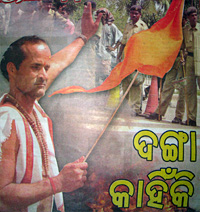‘Protect minorities or quit’, top judges tell Orissa Government
by - 6th January 2009
 Christians are still being targeted in the most economically deprived state on the subcontinent, as the Hindutva ‘India for Hindus’ movement whips up hatred against them.
Christians are still being targeted in the most economically deprived state on the subcontinent, as the Hindutva ‘India for Hindus’ movement whips up hatred against them.
Up to 50,000 displaced Christians are still living in camps; an unknown number have been killed, and houses and shops continued to be burned over Christmas and New Year, following the assassination of a Vishwa Hindu Parishad leader by a Maoist faction in 2008.
The bench comprising Chief Justice K.G. Balakrishnan, Justice Markandey Katju and Justice P. Sathasivam asked the Orissa government to reconstruct churches damaged during the violence.
Evangelical Fellowship of India reported that Justice Katju, the newest member on the bench, said: ‘We will not accept the persecution of minority. If the state government is unable to protect them it should resign. We have to protect the minorities… No minority community should be insecure in the country’, Justice Katju said.
‘It is the duty of the state government to protect the minority community. You (state) have done this only after 50,000 people of the minority community fled to the jungles,’ he stated.
The top court in the land, based in Delhi, had in October directed the stationing of para-military forces in the riot-hit areas until after Christmas. This week it went further, asking the state government not to take any unilateral decision on troop withdrawals.
The court was hearing a petition filed by Roman Catholic Archbishop of Cuttack, Raphael Cheenath seeking military intervention to stem the violence which erupted in Kandhamal District of Orissa against Christians.
Although a Naxalite faction claims responsibility for the gunning down of VHP leader Laxmanananda Saraswati on August 23, 2008 at his ashram, mobs used the murder for political ends.
Christians number just two per cent of the country’s one billion people. Many whom the church educates and who could therefore contribute to the future of Orissa migrate.
Hindu nationalism began as a response to nineteenth-century British moves to grant political representation on the basis of religious affiliation, following the first Census in 1871, which rendered potent such issues as numbers, identity and religious symbolism.
Hindus in Orissa are largely reluctant to turn against those with whom they have lived peaceably for centuries.
Social worker Sanjay Sahu, 35, who has just returned to Delhi from Bolangir told Lapido Media: ‘We are very close to each other there. We keep all our documents in their houses! They don’t want to be part of something they say is just political, but these BJP are trying to convince them that this is a fight against Christianity. ’
In 1999, Orissa Australian leprosy worker Graham Staines and his two young sons aged 7 and 9, were burned alive as they slept in their vehicle following a camp visit in the remote southern area.
Thirteen members of Bajrang Dal, the VHP youth wing who are thought to be behind the recent horrific violence, were accused of the murders. Calls for them to be banned are still being discussed.
Bajrang is one of the names of Hanuman, the monkey god venerated by many Hindus because, according to the Ramayana,he used his strength in the service of the god Rama, killing Ravana who had stolen Rama’s wife Sita.
It is common in India to hear coolies shouting ‘Jai bajrang bali’ –‘ Victory to the power of bajrang’ - to summon the strength to lift heavy weights.
- Log in to post comments
